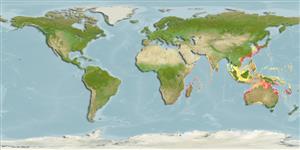Actinopterygii (ray-finned fishes) >
Tetraodontiformes (Puffers and filefishes) >
Ostraciidae (Boxfishes)
Etymology: Tetrosomus: Greek, tetra = four + Greek, soma = body (Ref. 45335).
Environment / Climate / Range
Ecology
Marine; reef-associated; depth range ? - 60 m (Ref. 3141). Temperate, preferred ?; 30°N - 35°S, 19°E - 170°E
Indo-West Pacific: East Africa to southern Japan and New Caledonia (Ref. 11897).
Size / Weight / Age
Maturity: Lm ? range ? - ? cm
Max length : 30.0 cm TL male/unsexed; (Ref. 3141)
Enters muddy bays or estuaries; usually with large remote sponges (Ref. 48637). Solitary. Also found in seagrass and weed bottoms of coastal reefs (Ref. 90102).
Life cycle and mating behavior
Maturity | Reproduction | Spawning | Eggs | Fecundity | Larvae
Smith, M.M., 1986. Ostraciidae. p. 890-893. In M.M. Smith and P.C. Heemstra (eds.) Smiths' sea fishes. Springer-Verlag, Berlin. (Ref. 3141)
IUCN Red List Status (Ref. 115185)
CITES (Ref. 94142)
Not Evaluated
Threat to humans
Harmless
Human uses
More information
Common namesSynonymsMetabolismPredatorsEcotoxicologyReproductionMaturitySpawningFecundityEggsEgg development
ReferencesAquacultureAquaculture profileStrainsGeneticsAllele frequenciesHeritabilityDiseasesProcessingMass conversion
Tools
Special reports
Download XML
Internet sources
Estimates of some properties based on models
Phylogenetic diversity index (Ref.
82805): PD
50 = 0.5625 [Uniqueness, from 0.5 = low to 2.0 = high].
Bayesian length-weight: a=0.03631 (0.01756 - 0.07509), b=2.81 (2.63 - 2.99), in cm Total Length, based on LWR estimates for this (Sub)family-body shape (Ref.
93245).
Trophic Level (Ref.
69278): 3.5 ±0.4 se; Based on size and trophs of closest relatives
Resilience (Ref.
69278): High, minimum population doubling time less than 15 months (Fec assumed to be > 10,000).
Vulnerability (Ref.
59153): Low vulnerability (17 of 100) .
